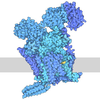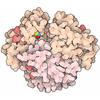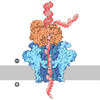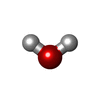Entry Database : PDB / ID : 3nyjTitle Crystal Structure Analysis of APP E2 domain Amyloid beta A4 protein Keywords / / Function / homology Function Domain/homology Component
/ / / / / / / / / / / / / / / / / / / / / / / / / / / / / / / / / / / / / / / / / / / / / / / / / / / / / / / / / / / / / / / / / / / / / / / / / / / / / / / / / / / / / / / / / / / / / / / / / / / / / / / / / / / / / / / / / / / / / / / / / / / / / / / / / / / / / / / / / / / / / / / / / / / / / / / Biological species Homo sapiens (human)Method / / / / Resolution : 3.2 Å Authors Ha, Y. / Hu, J. / Lee, S. / Liu, X. Journal : Biochemistry / Year : 2011Title : The E2 Domains of APP and APLP1 Share a Conserved Mode of Dimerization.Authors : Lee, S. / Xue, Y. / Hu, J. / Wang, Y. / Liu, X. / Demeler, B. / Ha, Y. History Deposition Jul 15, 2010 Deposition site / Processing site Revision 1.0 Jun 1, 2011 Provider / Type Revision 1.1 Jul 13, 2011 Group Revision 1.2 Nov 8, 2017 Group / Category / Item Revision 1.3 Nov 20, 2024 Group Data collection / Database references ... Data collection / Database references / Derived calculations / Structure summary Category chem_comp_atom / chem_comp_bond ... chem_comp_atom / chem_comp_bond / database_2 / pdbx_entry_details / pdbx_modification_feature / pdbx_struct_conn_angle / struct_conn / struct_ref_seq_dif / struct_site Item _database_2.pdbx_DOI / _database_2.pdbx_database_accession ... _database_2.pdbx_DOI / _database_2.pdbx_database_accession / _pdbx_struct_conn_angle.ptnr1_auth_seq_id / _pdbx_struct_conn_angle.ptnr3_auth_seq_id / _pdbx_struct_conn_angle.value / _struct_conn.conn_type_id / _struct_conn.id / _struct_conn.pdbx_dist_value / _struct_conn.pdbx_leaving_atom_flag / _struct_conn.ptnr1_auth_comp_id / _struct_conn.ptnr1_auth_seq_id / _struct_conn.ptnr1_label_asym_id / _struct_conn.ptnr1_label_atom_id / _struct_conn.ptnr1_label_comp_id / _struct_conn.ptnr1_label_seq_id / _struct_conn.ptnr2_auth_comp_id / _struct_conn.ptnr2_auth_seq_id / _struct_conn.ptnr2_label_asym_id / _struct_conn.ptnr2_label_atom_id / _struct_conn.ptnr2_label_comp_id / _struct_conn.ptnr2_label_seq_id / _struct_ref_seq_dif.details / _struct_site.pdbx_auth_asym_id / _struct_site.pdbx_auth_comp_id / _struct_site.pdbx_auth_seq_id
Show all Show less
 Open data
Open data Basic information
Basic information Components
Components Keywords
Keywords Function and homology information
Function and homology information Homo sapiens (human)
Homo sapiens (human) X-RAY DIFFRACTION /
X-RAY DIFFRACTION /  SYNCHROTRON /
SYNCHROTRON /  MOLECULAR REPLACEMENT /
MOLECULAR REPLACEMENT /  molecular replacement / Resolution: 3.2 Å
molecular replacement / Resolution: 3.2 Å  Authors
Authors Citation
Citation Journal: Biochemistry / Year: 2011
Journal: Biochemistry / Year: 2011 Structure visualization
Structure visualization Molmil
Molmil Jmol/JSmol
Jmol/JSmol Downloads & links
Downloads & links Download
Download 3nyj.cif.gz
3nyj.cif.gz PDBx/mmCIF format
PDBx/mmCIF format pdb3nyj.ent.gz
pdb3nyj.ent.gz PDB format
PDB format 3nyj.json.gz
3nyj.json.gz PDBx/mmJSON format
PDBx/mmJSON format Other downloads
Other downloads https://data.pdbj.org/pub/pdb/validation_reports/ny/3nyj
https://data.pdbj.org/pub/pdb/validation_reports/ny/3nyj ftp://data.pdbj.org/pub/pdb/validation_reports/ny/3nyj
ftp://data.pdbj.org/pub/pdb/validation_reports/ny/3nyj Links
Links Assembly
Assembly

 Components
Components Homo sapiens (human) / Gene: A4, AD1, APP / Plasmid: pET28 / Production host:
Homo sapiens (human) / Gene: A4, AD1, APP / Plasmid: pET28 / Production host: 
 X-RAY DIFFRACTION / Number of used crystals: 1
X-RAY DIFFRACTION / Number of used crystals: 1  Sample preparation
Sample preparation SYNCHROTRON / Site:
SYNCHROTRON / Site:  NSLS
NSLS  / Beamline: X29A / Wavelength: 1.14 Å
/ Beamline: X29A / Wavelength: 1.14 Å molecular replacement
molecular replacement Processing
Processing MOLECULAR REPLACEMENT / Resolution: 3.2→40 Å / Occupancy max: 1 / Occupancy min: 0.1 / σ(F): 0 / σ(I): 0 / Stereochemistry target values: Engh & Huber
MOLECULAR REPLACEMENT / Resolution: 3.2→40 Å / Occupancy max: 1 / Occupancy min: 0.1 / σ(F): 0 / σ(I): 0 / Stereochemistry target values: Engh & Huber Movie
Movie Controller
Controller





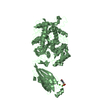
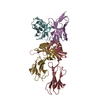
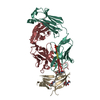




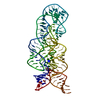
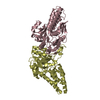
 PDBj
PDBj






